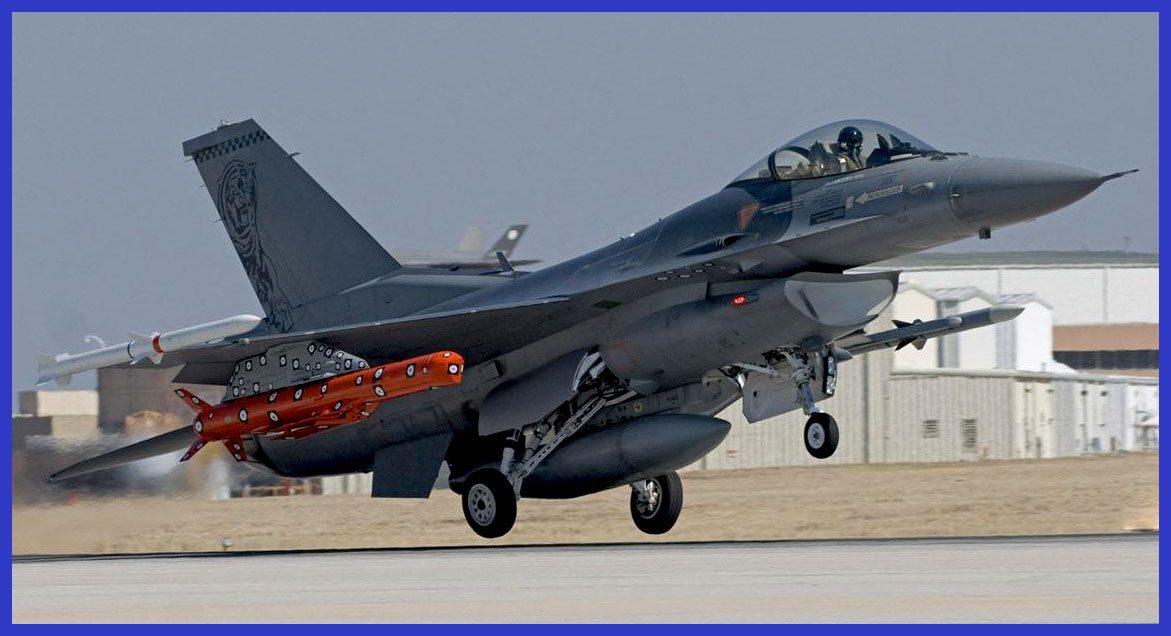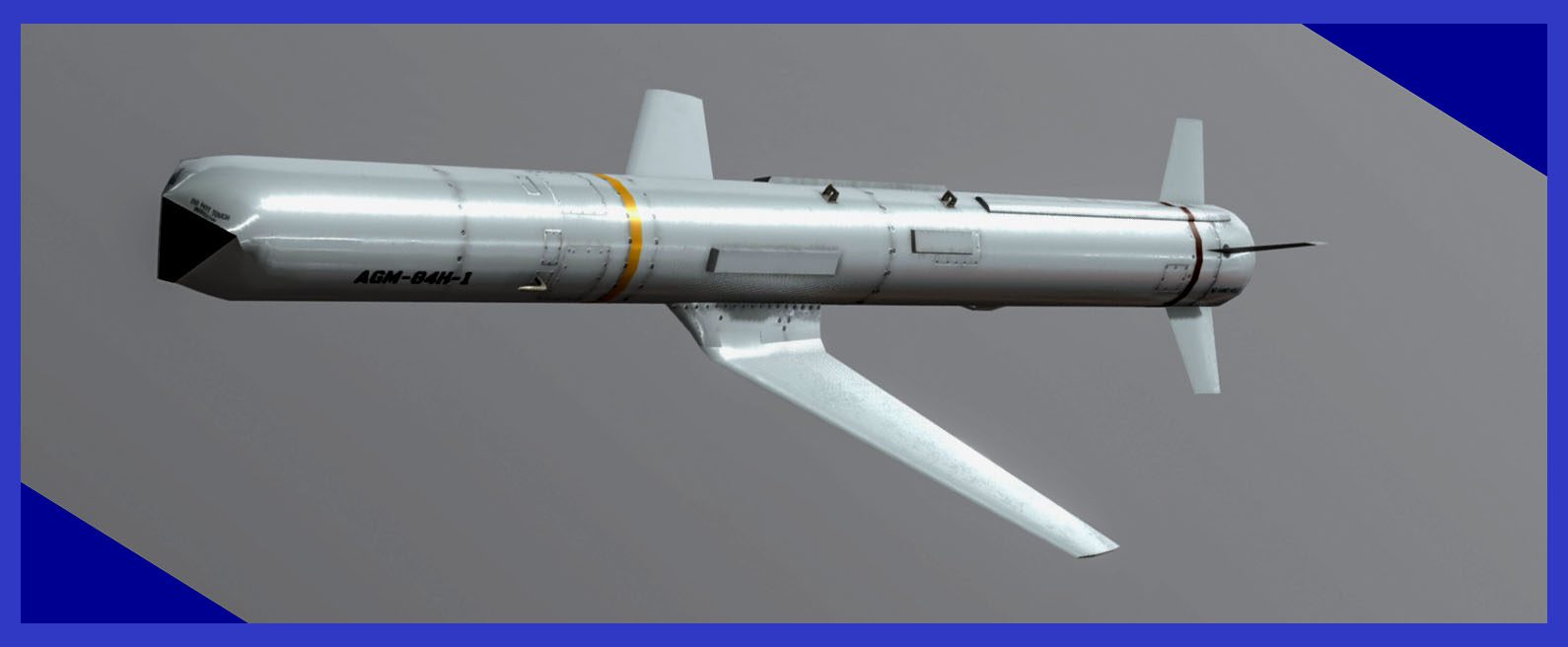Designed to engage a variety of land and sea targets with pinpoint accuracy, making it a versatile weapon in modern warfare. Let’s Explore the AGM-84H/K SLAM-ER Cruise Missile which was produced by Boeing.
The SLAM-ER program aimed to create a versatile weapon system capable of engaging targets on land and at sea with high precision and from extended ranges. The missile was intended to be launched from various aircraft platforms, including fighters and bombers, to enhance the operational flexibility of the U.S. military. During the development process, the SLAM-ER underwent significant upgrades and improvements to its guidance, navigation, and targeting systems.
These advancements included the incorporation of GPS and INS for accurate navigation, as well as a multimode seeker to effectively track and engage targets. The SLAM-ER achieved initial operational capability in the late 1990s and has since undergone further enhancements with the introduction of the AGM-84K Block II variant. The Block II version featured improved seeker and communication systems, enhancing the missile’s overall performance and target engagement capabilities.

The SLAM-ER possesses the remarkable capability to engage both land and sea targets at medium to long ranges, with a maximum distance exceeding 170 miles (270 km). Navigation and control rely on the Global Positioning System (GPS) and infrared imaging, enabling the missile to effectively strike stationary as well as moving targets. During the flight, the SLAM-ER can be remotely controlled and redirected to an alternative target if the original one has been neutralized or is deemed no longer threatening (command guidance).
Notably, the SLAM-ER exhibits exceptional precision, with an estimated circular error probable (CEP) of 3 to 4 meters, as of 2009. This level of accuracy surpasses that of any other missile utilized by the U.S. Navy. Its ability to strike targets from standoff distances, combined with its versatility and reliability, has rendered it an invaluable asset for the U.S. military in fulfilling its mission objectives.
In 1999, Boeing collaborated with the U.S. Navy to successfully test the SLAM-ER cruise missile on the decommissioned USS Dale (CG-19) off Puerto Rico. This test marked a significant milestone, leading to the missile’s initial operating capability in June 2000. The SLAM-ER was subsequently used in limited numbers during the Iraq War and Operation Enduring Freedom. As of 2023, the SLAM-ER is not only employed by the United States but also by five other countries: South Korea, Saudi Arabia, Turkey, the United Arab Emirates (UAE), and Taiwan.

Design Analysis of the AGM-84H/K SLAM-ER:
The design of the AGM-84H/K SLAM-ER (Standoff Land Attack Missile-Expanded Response) incorporates several key elements to ensure its effectiveness and versatility in engaging a wide range of targets.
Airframe and Control Surfaces: The SLAM-ER boasts a streamlined airframe that has been meticulously crafted to deliver optimal aerodynamic performance. This thoughtfully designed structure empowers the missile to achieve high speeds, maximize its range, and maintain exceptional stability throughout its flight trajectory. The missile’s control surfaces, including wings and fins, play a crucial role in its flight control and manoeuvrability.
These surfaces enable the SLAM-ER to make trajectory adjustments, perform mid-course corrections, and engage targets with remarkable precision. The design of the control surfaces not only ensures stability but also enhances manoeuvrability, ultimately optimizing the missile’s flight profile. Notably, from a frontal perspective, the wing design bears a resemblance to the iconic Junkers Ju 87 Stuka aircraft of the Second World War era.
Seeker System: The SLAM-ER missile is equipped with an advanced multimode seeker system comprising an infrared seeker, a laser spot tracker, and a passive radar homing receiver. This comprehensive combination empowers the SLAM-ER to effectively detect, track, and engage targets utilizing various modes. The infrared seeker enables target acquisition by detecting heat signatures, while the laser spot tracker enhances tracking precision. The passive radar-homing receiver plays a crucial role in detecting and tracking targets through the analysis of radar emissions.
To support the SLAM-ER’s functionality, the General Electric Company provides an Automatic Target Recognition Unit (ATRU). The ATRU processes prelaunch and postlaunch targeting data facilitates high-speed video comparison (DSMAC) and enables the SLAM-ER to be deployed in a true “fire and forget” manner. Additionally, the ATRU includes a “man-in-the-loop” mode, granting the pilot or weapons system officer the ability to designate the precise point of impact, even in scenarios where the target lacks a distinctive infrared signature.
Guidance and Navigation: The SLAM-ER incorporates sophisticated guidance and navigation systems to guarantee accurate target engagement. It utilizes an Inertial Navigation System (INS) along with the Global Positioning System (GPS), Infrared homing terminal guidance, Command guidance data link to the controlling aircraft, and DSMAC Automatic Target Acquisition (ATA). This seamless integration allows the SLAM-ER to attain precise positioning, execute course corrections, and navigate with utmost accuracy towards the target area. The combination of these advanced systems empowers the missile to cover extensive distances while seamlessly adapting to dynamic and evolving conditions.
Warhead: The SLAM-ER is equipped with an 800-pound (360-kilogram) WDU-40/B penetrating blast fragmentation warhead. The precise details regarding the warhead’s design characteristics, including its explosive composition and penetration capabilities, are likely classified. However, it is designed to deliver substantial damage to a wide range of targets, including hardened structures, surface ships, and armoured vehicles.

Technical Specifications of the AGM-84H/K SLAM-ER Cruise Missile:
- Weight: 675 kg ( 1,488 lb )
- Length: 14.3 ft ( 4.35 m )
- Diameter: 13.5 in
- Wingspan: 8 ft ( 2.43 m )
- Warhead: WDU-40/B Penetrating Blast Fragmentation, Weighing 360 kg ( 794 lb )
- Detonation: Impact fuse
- Engine: Teledyne CAE J402-CA-400, Turbojet engine
- Range: 270 km ( 168 mi )
- Accuracy: Estimated, 9ft 10 in ( 3 m ) circular error probable ( CEP )
- Speed: Subsonic estimated speed of around 855 km/h ( 531 mph, 0.700 Mach )
- Guidance system: Global Positioning System ( GPS ) / inertial navigation system ( INS )
- Launch Platform: The SLAM-ER cruise missile can be launched and controlled by a diverse range of American aircraft that adhere to NATO standards. These include the F/A-18 Hornet, F/A-18 Super Hornet, F-16 Block 50+, P-3C Orion, P-8 Poseidon, and F-15E. Before the retirement of the S-3B Viking, it was also capable of launching and controlling the SLAM-ER. Additionally, since 2006, the F-15K Slam Eagle, the South Korean Air Force’s variant of the F-15E Strike Eagle, has successfully demonstrated its ability to launch and control the SLAM-ER in test exercises.

Moreover, don’t miss the exclusive opportunity to acquire exquisite large-scale 1/72 premium die-cast models of the formidable Lockheed S-3B Viking and F-15E Strike Eagle. These remarkable military aircraft are now conveniently available on AirModels. Click here to access these exceptional models before the stock runs out.
In conclusion, the AGM-84H/K SLAM-ER cruise missile represents a highly capable and versatile weapon system that provides the U.S. military with a potent precision strike capability. With its advanced guidance and navigation systems, including GPS and INS, coupled with a multimode seeker, the SLAM-ER can engage a wide range of land and sea targets with remarkable accuracy. Its design prioritizes effective target acquisition, tracking, and engagement, while the inclusion of a data link communication system enhances its flexibility and adaptability in dynamic combat scenarios.
The SLAM-ER’s streamlined airframe, control surfaces, and electronic countermeasures contribute to its stability, manoeuvrability, and ability to counter enemy defences. By combining these features, the SLAM-ER offers a stand-off capability, reducing the risk of launching platforms while maintaining a high level of operational effectiveness. Overall, the AGM-84H/K SLAM-ER stands as a formidable weapon, enabling the U.S. military to achieve mission success with precision, and versatility, and minimize collateral damage.
Important Announcement for Our Valued Readers!
After an article is published, it is possible that updates or changes may have occurred beyond the time of publication. Therefore, it is important to be aware that certain information in the article might be outdated. To ensure the most accurate analysis, it is highly recommended to verify the content with the latest sources available.
However, we are dedicated to delivering outstanding articles on military products and global updates. Maintaining quality and smooth operation requires resources. Your support sustains our efforts in providing insightful content. By purchasing high-quality products through our affiliated links, you help us keep our platform alive and acquire top-notch items. Your unwavering support is invaluable and inspires us to strive further.
We welcome your suggestions and requests for more information, as we value feedback from our readers. If there’s specific defence material or equipment not covered on our site, please share your request in the comments. We’ll strive to research and provide the required information. We sincerely thank you for your unwavering interest in our website, and we eagerly anticipate hearing from you! Enjoy your reading experience!

